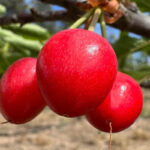China's cherry production and imports expected to continue growing this season

The latest 'Stone Fruit Annual' report, released in July by the U.S. Department of Agriculture's Foreign Agricultural Service, forecasts that China's cherry production and imports will increase this market year.
China's cherry production is projected to increase by 6% in the 2024/25 market year, reaching 850,000 metric tons, according to the report.
The increase is attributed to cherry acreage expansion and higher fruit yields. Consumption is also expected to rise as supplies improve.
Sales of imported cherries, particularly counter-seasonal cherries from Southern Hemisphere countries, are also expected to rise, largely due to enhanced marketing efforts in lower-tier cities.
Cherry imports
Imports are projected to increase to 420,000 metric tons this season, mainly on account of intensified marketing efforts by exporting countries. The increase in imports can be mainly attributed to supply increases from Chile, the single largest supplier whose cherry production is projected to double in the coming years on expanded crop area, according to industry sources.
China’s cherry imports from the United States, the largest supplier in the northern hemisphere, are also expected to continue to increase in MY 2024/25. Industry sources indicate that a projected production gain with adequate fruit size and brix level, will attract the attention of Chinese buyers.
Cherry imports from the United States rebounded sharply in MY 2023/24 from MY 2022/23 when low temperatures had dramatically reduced exportable supplies.
Local Cherry Supply
As the fruit continues to spread throughout the country, the pace has slowed and the planted area has stabilized in traditional cherry-producing provinces like Liaoning and Shandong after the central government introduced policies to regulate the use of farmland.
The rate of growth has slowed but China’s cherry-planted area is still expected to increase. Cherry hectares are expected to grow from 193,000 hectares in the 2023/24 season to 199,000 hectares in the 2024/25 season.
Although a drought persists in certain parts of northern China, including the top cherry provinces, luckily, the cherry season in most northern areas ended before the drought got worse, meaning the adverse weather will only affect late-ripening cherries.
More farmers are turning to the fruit, due to the high market returns of cherry planting, farmers in Shanxi, Shaanxi and Gansu, Sichuan, Guizhou and Yunnan are encouraged to plant more cherries in mountainous or hilly areas.
Industry reports show that greenhouse production of cherries has developed rapidly in high-altitude and cold areas such as Inner Mongolia, Xinjiang, Heilongjiang and Tibet. The proportion of greenhouse cherry production in Dalian has reached nearly 50%, but most cherries in the country are still grown in the open field.
Due to this, according to local farmers in Shandong, the Yantai government currently provides a subsidy of $10,417 per hectare for farmers to build rain shelters over cherry crops.
Cherry farmers, especially the ones in traditional production provinces such as Liaoning and Shandong, are actively replacing old cherry varieties, such as Red Lantern, with market-favored ones such as Russian No. 8, according to industry sources.
Other popular varieties include Beauty Early, Qizao, Jiahong, Rainier, Black Pearl, and Brooks. Chinese farmers favor early or mid-ripening varieties; late-ripening varieties, such as Lapins, Regina, and Kordia, take up a relatively small market share.
Prices and consumption
Cherry prices dropped significantly in MY 2024/25 compared to last year due to an increase in supplies and weak demand.
Beauty Early cherries were generally sold at $4.2 per kilo, down 25% on a year-over-year basis, according to vendors at a major cherry wholesale market near Yantai. However, industry sources indicate that the price of high-quality cherries (large, firm, dark color, and sweet) remains strong.
Top-grade cherries produced in greenhouses were purchased as high as $40 per kilo at farms between March and May, according to fruit traders in Dalian.
However, the report forecasts that consumption will increase as supplies improve.













































